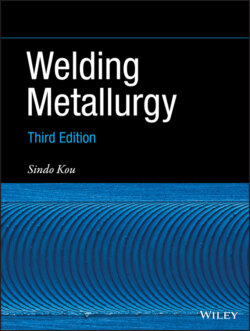Читать книгу Welding Metallurgy - Sindo Kou - Страница 101
3.7 Resistance Spot Welding
ОглавлениеWei et al. [60] pioneered the computer simulation of heat transfer and fluid flow in RSW. They further conducted a series of fundamental studies that better explained RSW [61–65], such as the effect of the magnetic properties of the workpiece, the contact resistance at the faying surface, the electrode‐workpiece interfaces, and the geometry of the electrode. Their studies can be a useful tool for further understanding of heat transfer and fluid flow in RSW without or with an externally applied magnetic field [66–70].
Recently, permanent magnets have been mounted on the electrodes in RSW to widen the nugget and increase the joint strength of the resistance spot weld. Such magnets, for example, can be 10 mm thick, 100 mm outer diameter and 40 mm inner diameter [66]. Figure 3.33 shows that, without the magnets the magnetic field (called induced magnetic field) in the faying surface is in the azimuthal (or circumferential) direction and the corresponding Lorenz force is inward toward the centerline of the electrodes. With the magnets, however, the magnetic field (called the external magnetic field) in the faying surface is outward in the radial direction and the corresponding Lorentz force is in the azimuthal direction.
Figure 3.33 RSW and MA‐RSW: (a) RSW; (b) MA‐RSW; (c) magnetic field and Lorentz force in RSW; (d) magnetic field and Lorentz force in MA‐RSW. MA: magnetic assisted.
Source: Yao, Luo, Li, Yan, and Duan [66]. © Elsevier.
The Lorentz force acts as the driving force for fluid flow in the nugget. Since the size of the nugget increases with time, the flow pattern in the nugget changes significantly with time. Li et al. [67] calculated fluid flow and heat transfer in the nugget in RSW with the induced magnetic field, i.e., without external magnets. Figure 3.34a shows the calculated flow field at 0.35 s after welding starts. The maximum velocity is about 0.43 m/s outward, located on the faying surface at about three‐quarters of the nugget radius from the electrode axis. The flow pattern is sketched schematically in Figure 3.34b. It shows two toroidal‐shaped flow loops near the edge of the nugget, one above the faying surface and the other below it. Both loops show a radially outward flow at the faying surface. The two big arrowheads at the faying surface indicate the location of the maximum velocity. The temperature field in Figure 3.34c shows a maximum temperature of about 1797 °C near the nugget edge. Further computer modeling that includes external magnets may help explain their effect on heat transfer and fluid flow in RSW.
Figure 3.34 Calculated results of RSW with induced magnetic field: (a) velocity field at time = 0.35 s; (b) flow loops illustrating velocity field in (a); (c) temperature field at time = 0.35 s.
Source: Li, Lin, Shen, and Lai [67]. © Wiley.
The nugget diameter can be increased significantly with the help of the magnets. In Figure 3.35 it increases from 4.21 to 4.70 mm [69]. With an increased nugget diameter, the bonding area between the upper and lower sheets and hence the joint strength can increase significantly. In fact, since the liquid in the nugget is stirred by fluid flow during solidification, grain refining can also occur to improve the joint strength. In tensile‐shear testing, the failure mode can change from the interfacial mode of weaker welds to the button‐pullout mode of stronger welds when magnets are used. The load‐displacement curves confirm the improved weld strength and ductility. Similar improvement was also observed in RSW of AZ31 Mg [66]. Finally, it is interesting to note that magnets can also improve Al/Ti dissimilar‐metal RSW [71]. Grain refining was observed in the weld made with magnets, again suggesting enhanced electromagnetic stirring.
Figure 3.35 Resistance spot welds of DP980 steel: (a) (b) (c) thicknesses and diameters (in mm) and grain structures of nuggets; (d) typical load‐displacement curves in tensile‐shear tests. MA‐RSW: magnetically assisted resistance spot welding.
Source: Li, Li, Shen, Lin [69]. Welding Journal, April 2013, © American Welding Society.
